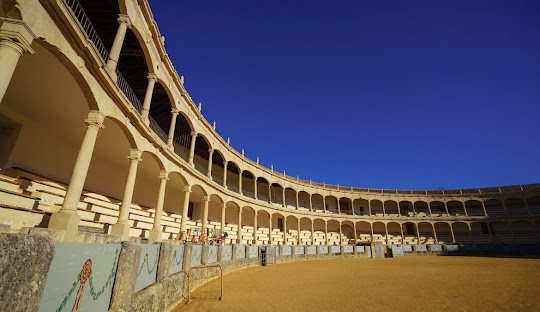Ronda, Spain
🌉 Ronda, Spain: Clifftop Majesty & Andalusian Soul
Perched dramatically above the El Tajo Gorge in Spain’s sun-drenched Andalusia region, Ronda is one of the most visually striking towns in Europe. With whitewashed buildings teetering on cliffs, historic bridges, and a rich blend of Moorish and Spanish traditions, Ronda is as romantic as it is rugged. It’s a place of legends, bullfighting, and poetry—a destination that once inspired writers like Hemingway and Rilke.
🌁 Puente Nuevo: The Icon of Ronda
-
Puente Nuevo (New Bridge): Towering 120 meters above the gorge, this 18th-century stone bridge connects Ronda’s old and new towns. The views are breathtaking—especially at sunset or from the Mirador de Aldehuela.
-
El Tajo Gorge: Carved by the Guadalevín River, the chasm splits the city in two and creates one of the most dramatic landscapes in all of Spain.
-
Puente Viejo & Puente Romano: Older bridges that showcase the evolution of Ronda’s cityscape across centuries.
These architectural marvels provide endless photo opportunities and a sense of timeless grandeur.
🏰 History Echoes Through Stone
-
La Ciudad (Old Town): Cobblestone alleys, tiled patios, and Islamic arches reflect Ronda’s Moorish past.
-
Arab Baths (Baños Árabes): Some of the best-preserved in Spain, these 13th-century baths offer a glimpse into daily life under Islamic rule.
-
Mondragón Palace: A former Moorish palace turned museum, with tranquil gardens and intricate tilework.
-
Ronda Walls & Gates: Walk along remnants of the medieval city walls for quiet views over olive groves and hills.
Ronda is a layered narrative of conquest, resistance, and romance.
🐂 The Cradle of Bullfighting
-
Plaza de Toros de Ronda: Built in 1785, this is one of Spain’s oldest and most revered bullrings. The Museum of Bullfighting inside offers a cultural deep dive, even if you're not a fan of the sport.
-
Feria de Pedro Romero: Held in September, it includes traditional Goyesque-style bullfights and parades celebrating Andalusian heritage.
Bullfighting may be controversial, but in Ronda, it’s presented as a deep cultural tradition—a window into Spain’s layered identity.
🍷 Andalusian Flavors in Ronda
-
Restaurante Bardal (2 Michelin Stars): Avant-garde Andalusian cuisine in a refined setting—perfect for food lovers seeking artistry.
-
Casa María: A beloved local spot offering no menu—just daily seasonal delights chosen by the chef.
-
De Locos Tapas: A creative fusion tapas bar tucked in the old town with international flair and local wine pairings.
-
Ronda Wine Route: The surrounding hills are home to boutique vineyards producing full-bodied reds and elegant rosés. Visit Bodega Joaquín Fernández or Descalzos Viejos for tours and tastings.
Ronda’s cuisine is hearty, inventive, and grounded in Andalusian terroir.
🏨 Where to Stay in Ronda
-
Luxury:
-
Parador de Ronda: Located beside the Puente Nuevo, this hotel offers rooms with epic views and four-star service.
-
-
Mid-Range:
-
Catalonia Ronda: Chic design, a rooftop pool, and views of the bullring.
-
-
Budget:
-
Hotel Ronda Nuevo: Affordable and central with clean, cozy rooms.
-
Many hotels boast balconies that overlook the gorge—a stay in Ronda is as much about where you sleep as what you see.
🌿 Nature & Beyond: Outdoor Wonders
-
Alameda del Tajo: A scenic park perfect for sunset walks and cliffside views.
-
Cueva del Gato (Cat’s Cave): A natural pool and cave system just outside Ronda, great for a day of hiking and cooling off.
-
Grazalema Natural Park: Nearby, this lush mountainous area offers trails, wildflowers, and traditional pueblos blancos (white villages).
Ronda is an outdoor paradise, blending raw nature with historical grandeur.
💡 Tips for Visiting Ronda
-
Getting There: Ronda is about 2 hours from Seville and 1.5 hours from Málaga by car or train.
-
Best Time to Visit: Spring and early fall (April–June, September–October) offer pleasant weather and fewer crowds.
-
Currency: Euro (€)
-
Local Insight: Many attractions close early in the afternoon—plan sightseeing before lunch and relax like a local during siesta time.
📸 Top Instagram Spots in Ronda
-
Standing on Puente Nuevo at golden hour 🌉
-
Gazing into the El Tajo Gorge from a café patio 🍷
-
Moorish tiles inside Mondragón Palace 🏺
-
Bullring silhouettes under dramatic Andalusian skies 🐂
-
Overlook from Jardines de Cuenca 🌄


